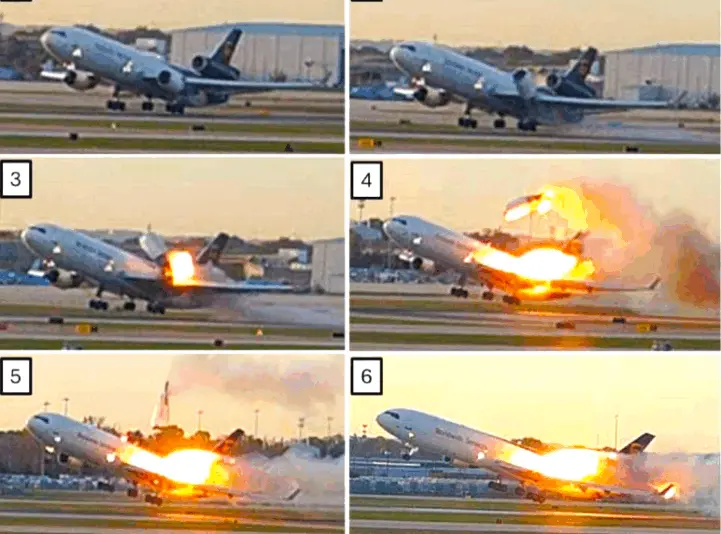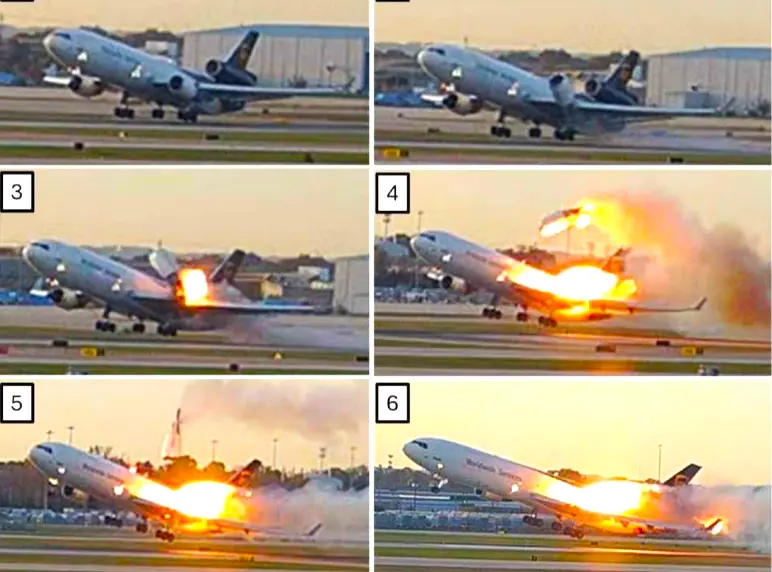
The preliminary findings of an National Transportation Safety Board (NTSB) investigation into the UPS plane crash at Louisville Muhammad Ali International Airports says that the mount that attached the left wing to the left engine showed signs of “fatigue cracks in addition to areas of overstress failure.”
The crash happened on November 4 at 3:14 (EST) when flight 2976, a Boeing (McDonnell-Douglas) MD-11F airplane, was destroyed after it impacted the ground shortly after takeoff from runway 17R.
The three crew members aboard the airplane and 11 people on the ground were killed, while 23 people on the ground were injured.
The attempted take off
The flight began normal enough, as the NTSB stated: “The taxi and takeoff roll were uneventful until the airplane rotated for takeoff. Airport surveillance video of the airplane showed the left (No. 1) engine and pylon separating from the wing shortly after airplane rotation, with a fire igniting on the left engine while it traversed above the fuselage and subsequently impacted the ground. A fire ignited near the area of the left pylon attachment to the wing, which continued until ground impact.”
The aircraft initially began climbing but did not get any higher than 30 feet above ground level (agl), according to radio altitude data from the flight data recorder (FDR). Although, based on FAA-provided Automatic Dependent Surveillance — Broadcast (ADS-B data), the last data point showed the plane at 100 feet above ground level, the NTSB said.
“The airplane cleared the blast fence beyond the end of runway 17R, but the left main landing gear impacted the roof of a UPS Supply Chain Solutions warehouse at the southern edge of the airport,” according to the NTSB report. “The airplane then impacted a storage yard and two additional buildings, including a petroleum recycling facility, and was mostly consumed by fire.”
The NTSB discovered during its examination of the wreckage that “the left engine, left pylon, including its forward and aft mounts, fragments of engine fan blades, and separated pieces from the left engine were found on and adjacent to runway 17R.”
Further examination showed that critical parts of the aircraft, specifically, the “left pylon aft mount’s forward and aft lugs, were both found fractured.”
These parts are responsible for connecting the engine to the wing.
Further examination revealed cracks and evidence of “overstress failure” on the critical parts.
“… Examination of the left pylon aft mount lug fractures found evidence of fatigue cracks in addition to areas of overstress failure,” the NTSB said. “On the aft lug, on both the inboard and outboard fracture surfaces, a fatigue crack was observed where the aft lug bore met the aft lug forward face.
“For the forward lug’s inboard fracture surface, fatigue cracks were observed along the lug bore. For the forward lug’s outboard fracture surface, the fracture consisted entirely of overstress with no indications of fatigue cracking.”
Aircraft maintenance
A review of the airplane’s maintenance schedule showed that the next inspection of the failed parts would have taken place when the aircraft reached 29,200 cycles (take offs and landings), but the plane had only 21,043 cycles (and 92,992 flight hours).
While the airplane was maintained under a “continuous airworthiness maintenance program,” according to the NTSB, the last time the left pylon aft mount underwent a “detailed visual inspection” or “general visual inspection” was in October 2021.
“A review of the inspection tasks for the left pylon aft mount found both a general visual inspection and a detailed visual inspection of the left pylon aft mount, required by UPS’s maintenance program at a 72-month interval, was last accomplished on October 28, 2021,” the NTSB found.
“A special detailed inspection of the left pylon aft mount lugs would have been due at 29,200 cycles, and of the left-wing clevis support (helps secure the engine to the underside of the wing) would have been due at 28,000 cycles,” the NTSB stated. “The accident airplane records showed these two … tasks had not been accomplished (the airplane had 21,043 cycles).”
(Headline photo: Chronological photos taken of the attempted takeoff of UPS Flight 2976, courtesy of Louisville Muhammad Ali International Airport via the NTSB)

By Ken Howlett, News Director
Contact Ken at ken@k105.com









